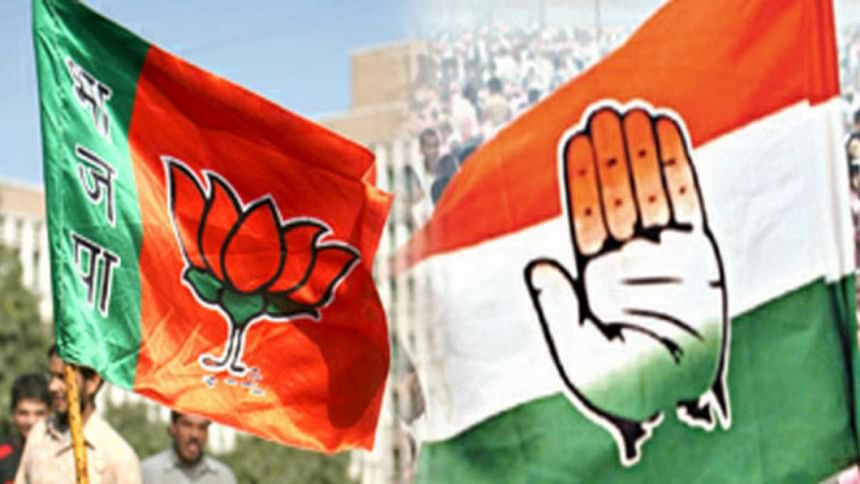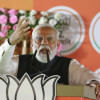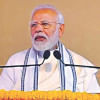How to read the State Assembly elections results in India?

The recent elections to four Indian states and one union territory are being interpreted by many as the march of the BJP and the decline of the Congress party. Is it so? Let's take a look at the results closely. In two states of West Bengal and Tamil Nadu, and the union territory of Pondicherry, the incumbent governments have been elected to power, and in two states of Assam and Kerala there is evident anti-incumbency votes. While in Assam, Kerala and Puducherry, the national parties - BJP, the Left and Congress - have assumed power respectably, in two other states, the regional political parties have assumed power. In Assam, Kerala and Pondicherry, the local political parties are extremely weak or non-existent and can't really pose a challenge to these national parties. In Assam, the BJP was able to form a coalition with the Assam Gana Sangram Parishad(AGP) whose electoral profile has been on the decline. In Kerala, the Left Democratic Front (LDF) managed to form a coalition with like-minded parties to win the election. Each of these elections was fought on local issues.
Let us look at the results in West Bengal. The government of Mamata Banerjee won decisively, winning 211 seats out of 294 seats. It won 45 percent of vote shares; the Congress and Left coalition received 39 percent of votes (Left, 27 seats and Congress, 12 seats) and BJP got 11 percent of votes. The Congress retained its support base and the Left lost its popular support marginally by 2 percent. Many attribute the failure to the unlikely coalition of two different parties that have historically been opposed to each other in the state. At the grass root level, the support base of the Left has been dismantled by Trinamool Congress (TMC). In spite of corruption charges highlighted by media, the TMC managed a decisive victory due to the weak organisation structures of both the political parties.
In Assam, BJP won a massive victory mainly on the populist issue of illegal immigration from Bangladesh – a theme that raises anxiety among the Assamese speakers – which was effectively used by BJP. This is the issue that the party has raised both during the national election and now. The illegal immigration issue did not get any traction in West Bengal, but it did strike a chord with the Assamese voters. From 5 seats in 2011, the party has won 60 seats in the recently concluded election. The anti-incumbency of 15 years of Congress rule was also a major factor, and added to it was the lack-lustre Congress campaign which failed to impress voters. Here, the two national political parties fought the election by targeting each other's performance.
In Kerala, the Left led LDF won 91 seats, polling 43.31 percent of votes while the Congress-led United Democratic Front (UDF) was victorious in 47 seats, receiving 38.86 percent of the votes. The Congress, which had won 38 seats in 2011, managed to win 22 seats. The corruption charges against Chandy's government, the internal trouble within the local party unit and the party's inability to assure the large Muslim voters are considered to be main reasons behind the defeat. Interestingly, BJP, which contested in 98 seats, got only one seat, reflecting the party's failure to penetrate the South.
Election results in Tamil Nadu are interesting, as for many seats where there was a direct contest between the Dravida Munnetra Kazhagam (DMK) and the All India Anna Dravida Munnetra Kazhagam (AIADMK), the DMK put a good fight and its share in the percentage of votes were more thanks to the campaign of M.K. Stalin who is all poised to succeed M. Karunanidhi. For example, the DMK and its allies polled 39.7 percent vote; 1.1 percent less than AIADMK's 40.8. DMK has 89 legislators, whereas Congress, its ally, could manage to win 8 seats. Though the DMK and Congress alliance in Tamil Nadu failed to bring desired results, it was a winning team in the union territory of Puducherry.
While many perceive these results to be a reflection of the decline of Congress, taking into consideration the fact that it was in the past the dominant national party, writing the obituary of the grand old party seems to be a bit far-fetched. It is true that Congress needs to get its act together and has to do some serious introspection. In the recent Assembly elections, it recorded its presence in all the states, unlike the BJP which could not make any electoral presence in Tamil Nadu and Puducherry and got only one seat in Kerala. Moreover, voters in India vote differently in the Assembly elections compared to the national elections, even though the regional political parties have a significant presence in national politics. The 2019 elections will be fought on national agendas like the state of the Indian economy, unemployment and foreign policy of the Modi government etc, rather than local issues that played a significant role in the Assembly election.
The Congress leadership remains weak and does not assure Indian voters that it can steer the country in the right direction, which does not only include economic growth but also ensure India's rightful place in global affairs. The Modi government has managed to project a clearheaded and decisive foreign policy, where it has been able to project India as a larger global player. However, its policies towards immediate neighbours, especially Pakistan and Nepal, have come under severe criticism. Due to weak and inarticulate leadership, Congress has not been able to gain from BJP's foreign policy blunders. If Congress wants to give BJP a strong fight, it needs to synergise its grassroots voters and rethink its strategy. Congress needs a decisive leader if it wants to fight an extremely articulate leader like Modi, whose style of speech delivery is convincing and assuring, even though it has failed sometimes in the past. Congress' weakness is that it cannot think beyond the dynasty. If it cannot reinvent itself, there could be a decisive and irreversible decline of the grand old party, which can reduce itself, at best to become a kingmaker in a coalition, and at worst, to an insignificant political entity. There is still time for Congress to re-emerge, in spite of its lacklustre performance in the Assembly elections.
The writer is Research Fellow, IDSA.

 For all latest news, follow The Daily Star's Google News channel.
For all latest news, follow The Daily Star's Google News channel. 








Comments